Impact of Inter‐Basin Water Transfer Projects on Regional Ecological Security from a Telecoupling Perspective
Abstract
:1. Introduction
2. Methods and Materials
2.1. Telecoupling
2.2. Analysis Model of Impacts of IBWTPs on Regional Ecological Security
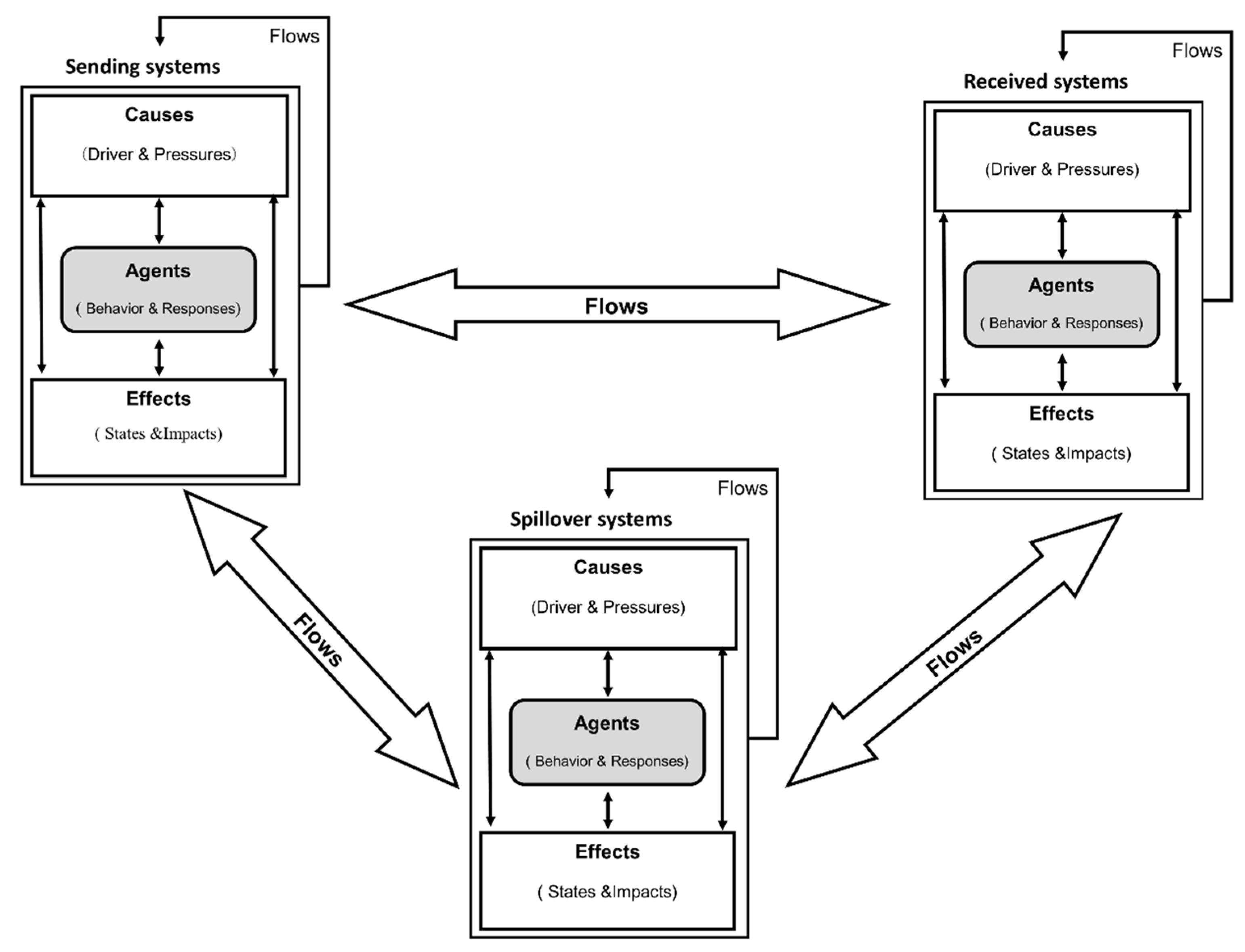
2.3. Study Areas
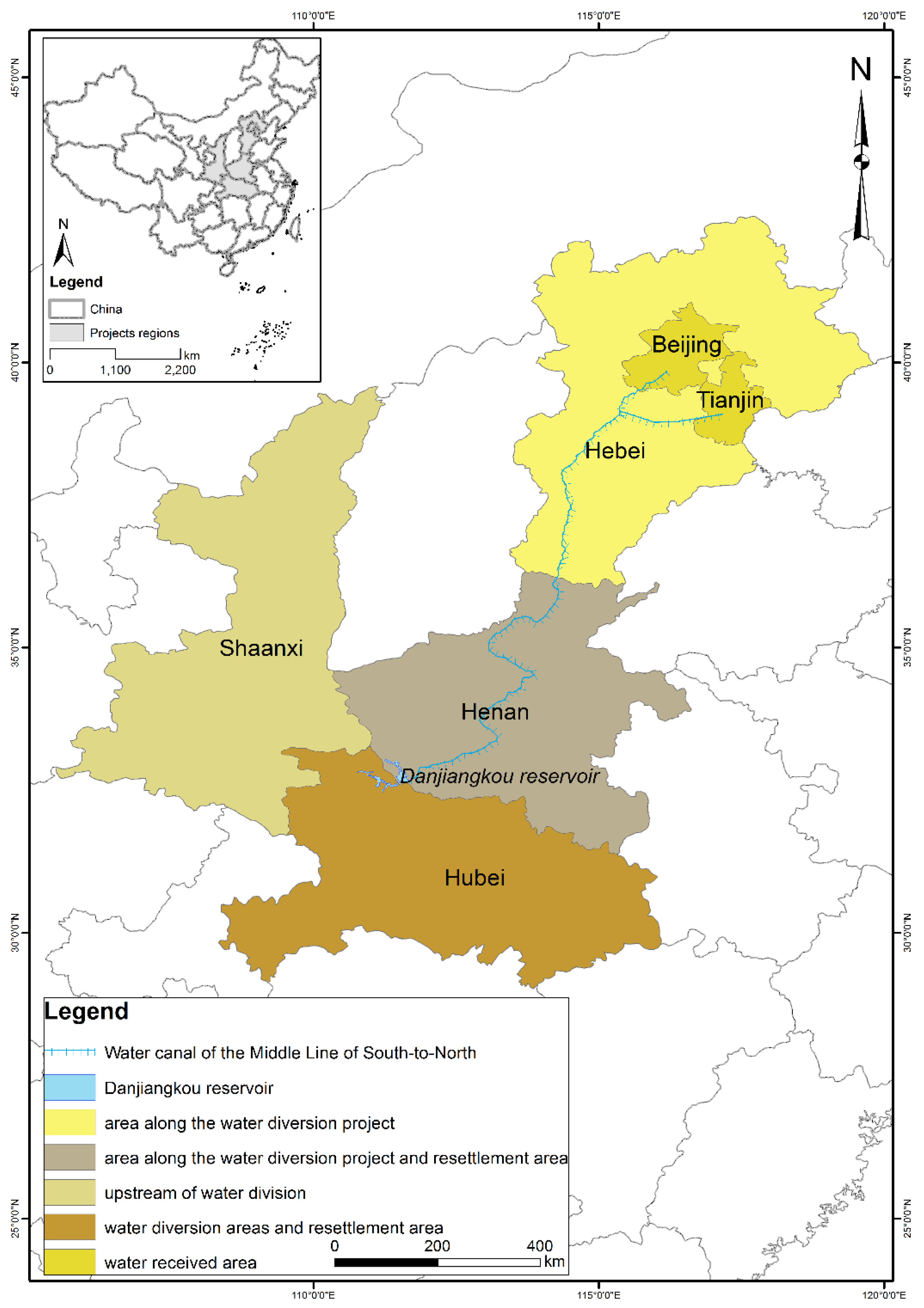
3. Case Study of the Middle Line of the South-to-North Water Diversion Project
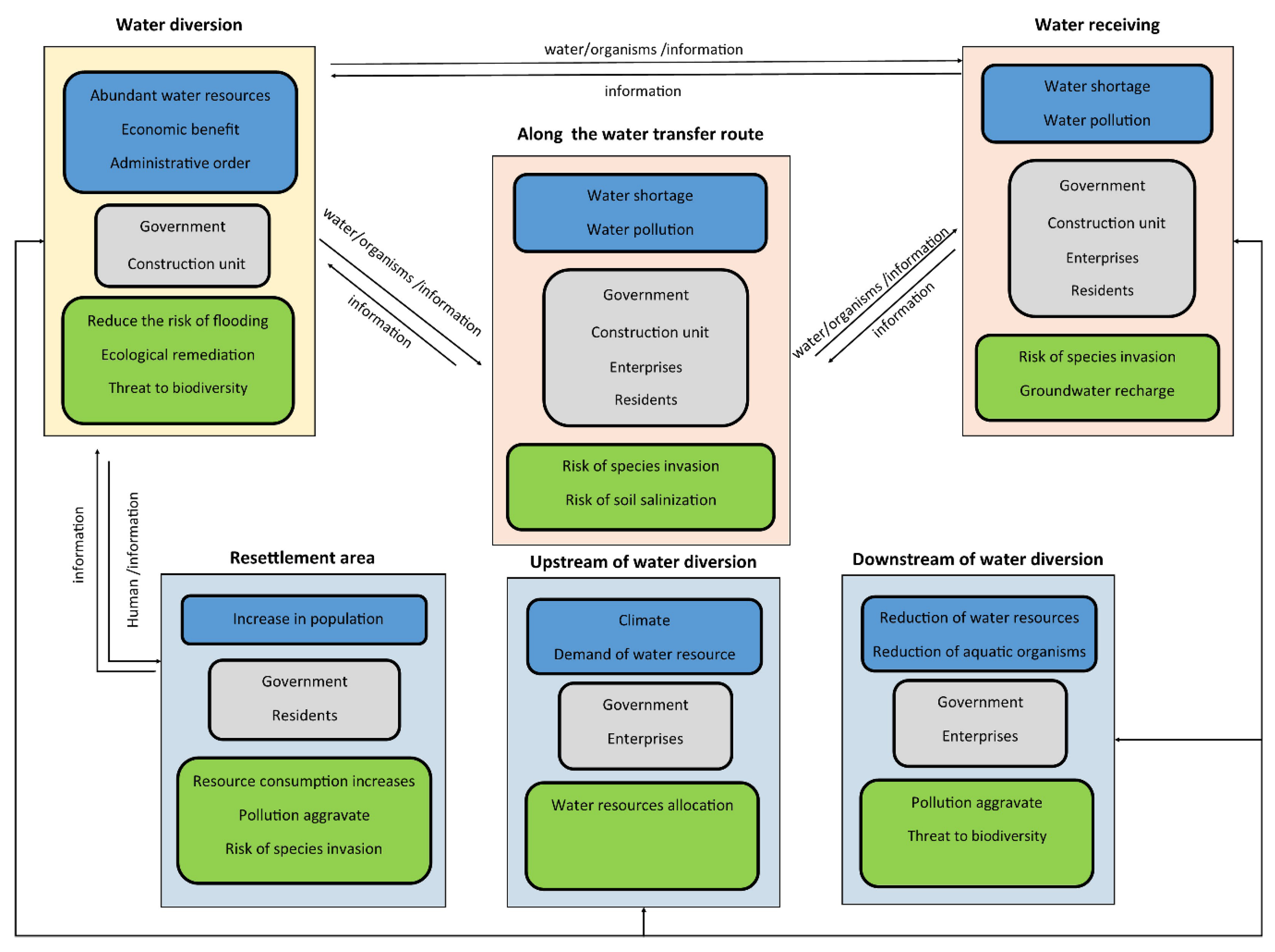
3.1. Complex Ecosystems
3.1.1. Sending Systems
3.1.2. Receiving Systems
3.1.3. Spillover Systems
3.2. Agents
3.3. Flows
3.4. Causes
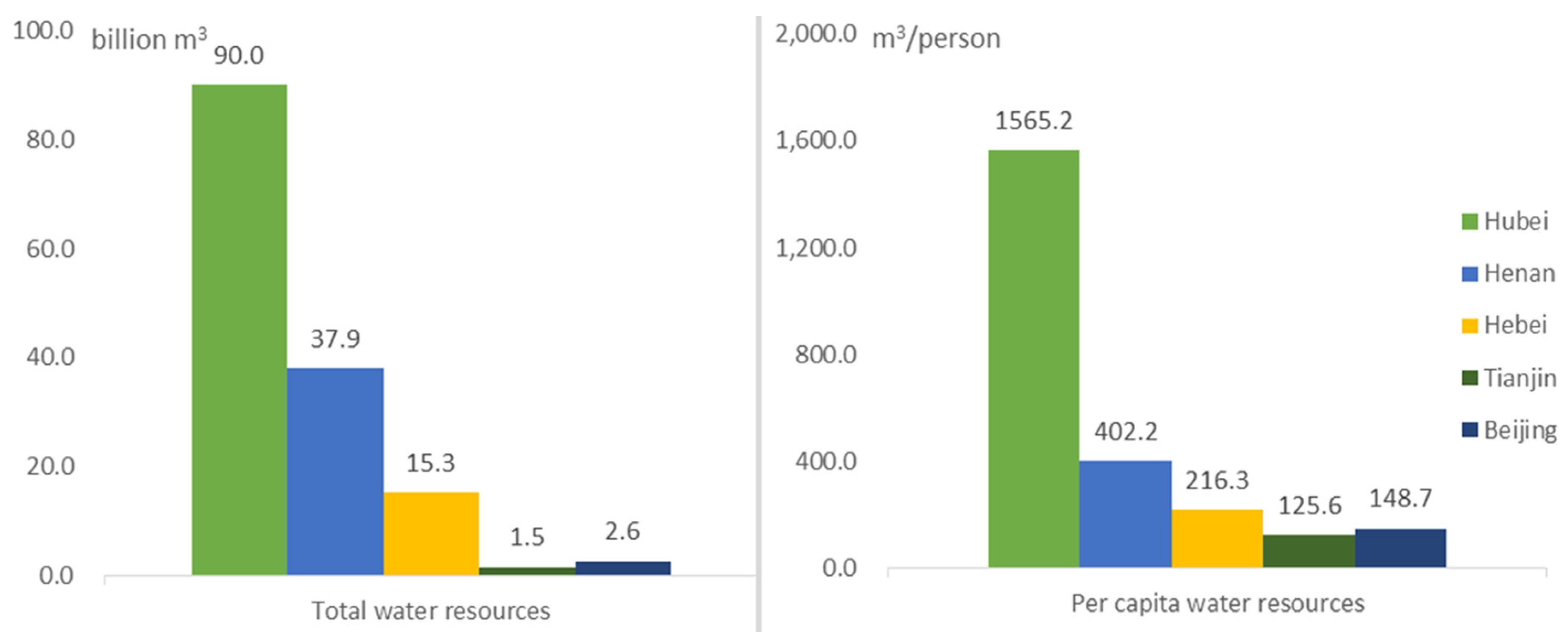
3.5. Effects
4. Discussion
4.1. Information Flows of Ecological Security
4.2. Assessment Method for Impacts of Ecological Security of IBWTPs
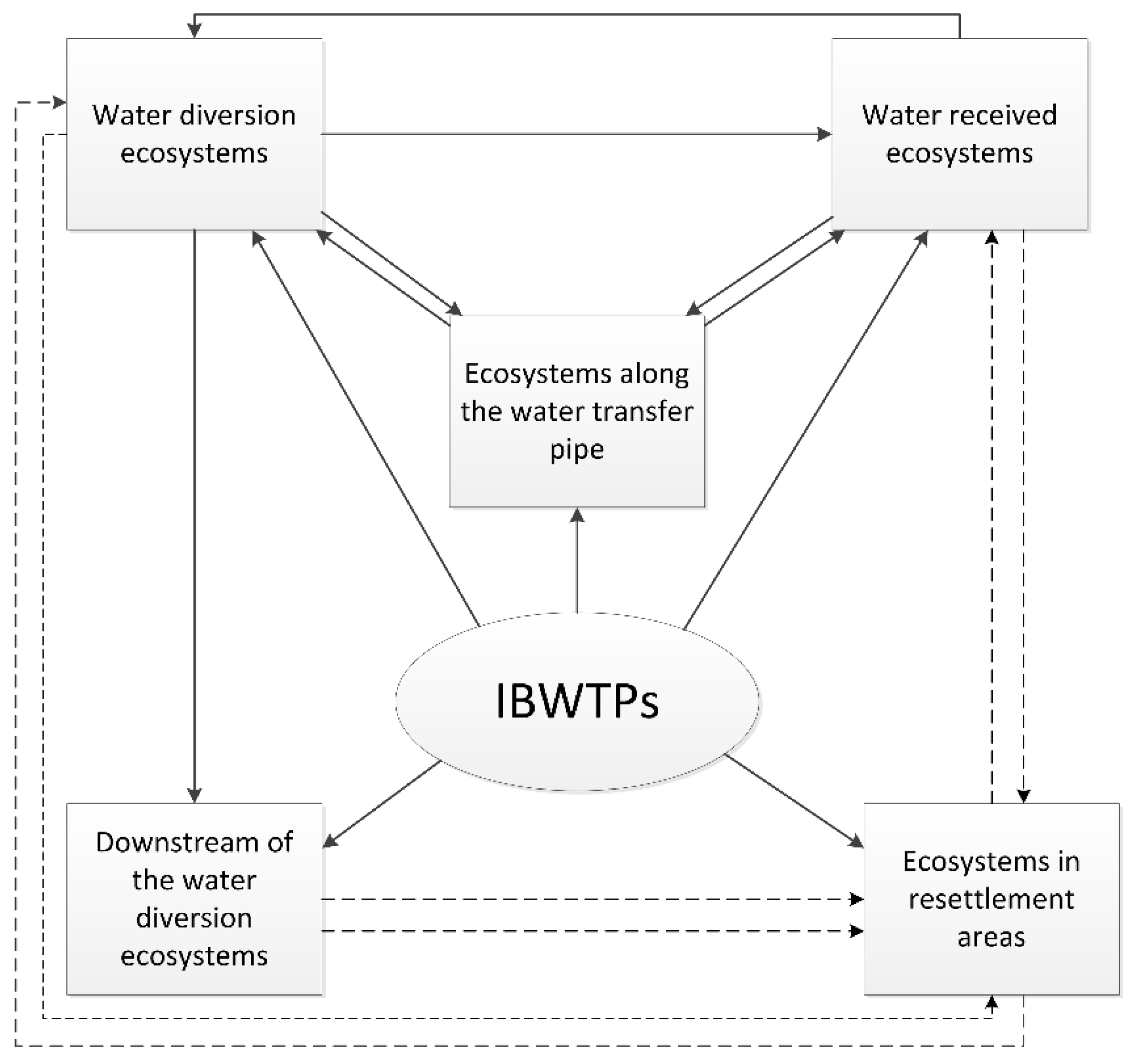
| Systems | Ecosystems | Regions | mEWRs (Billion m3) |
|---|---|---|---|
| Sending systems | Water diversion ecosystems | Danjiangkou Reservoir | 20.40 |
| Receiving systems | Water receiving ecosystems | Beijing | 0.59 |
| Tianjin | 0.09 | ||
| Ecosystems along the water diversion | Hebei Province | 0.47 | |
| Henan Province | 0.61 | ||
| Spillover systems | Downstream of the water diversion ecosystems | Downstream of the Han River | 1.32 |
| Ecosystems in resettlement areas | Hubei Province | 0.04 |
5. Conclusions
Acknowledgments
Author Contributions
Conflicts of Interest
References
- Zhang, L.; Li, S.; Loaiciga, H.A.; Zhang, Y.; Du, Y. Opportunities and challenges of interbasin water transfers: A literature review with bibliometric analysis. Scientometrics 2015, 105, 279–294. [Google Scholar] [CrossRef]
- Deines, J.M.; Liu, X.; Liu, J.G. Telecoupling in urban water systems: An examination of Beijing’s imported water supply. Water Int. 2015. [Google Scholar] [CrossRef]
- Jiang, R.G.; Xie, J.C.; Zhu, J.W.; Liu, H.H. Theoretical framework for ecological compensation of inter-basin water transfer project. Bull. Soil Water Conserv. 2015, 35, 273–278. (In Chinese) [Google Scholar]
- Matete, M.; Hassan, R. An ecological economics framework for assessing environmental flows: The case of inter-basin water transfers in Lesotho. Global Planet. Change 2005, 47, 193–200. [Google Scholar] [CrossRef]
- Zhu, M.Y.; Tan, S.D.; Zhang, Q.F. Economic loss estimation of soil erosion in water source area of Middle Route of South-to-North Water Transfer Project. Bull. Soil Water Conserv. 2014, 34, 190–195. (In Chinese) [Google Scholar]
- Lafreniere, C.K.; Deshpandea, S.; Bjornlund, H.; Hunter, G.M. Extending stakeholder theory to promote resource management initiatives to key stakeholders: A case study of water transfers in Alberta, Canada. J. Environ. Manag. 2013, 129, 81–91. [Google Scholar] [CrossRef] [PubMed]
- Micklin, P.P. Desiccation of the Aral Sea: A Water Management Disaster in the Soviet Union. Science 1998, 241, 1170–1176. [Google Scholar] [CrossRef] [PubMed]
- Micklin, P.P.; Aladin, N.V. Reclaiming the Aral Sea. Sci. Am. 2008, 298, 64–71. [Google Scholar] [CrossRef] [PubMed]
- Barnett, J.; Rogers, S.; Webber, M.; Finlayson, B.; Wang, M. Transfer project cannot meet China’s water needs. Nature 2015, 527, 295–297. [Google Scholar] [CrossRef] [PubMed]
- Aishan, T.; Halik, Ü.; Kurban, A.; Cyffka, B.; Kuba, M.; Betz, F.; Keyimu, M. Eco-morphological response of floodplain forests (Populus euphratica Oliv.) to water diversion in the lower Tarim River, northwest China. Environ. Earth. Sci. 2015, 73, 533–545. [Google Scholar] [CrossRef]
- Aishan, T.; Halik, Ü.; Cyffka, B.; Kuba, M.; Abliz, A.; Baidourela, A. Monitoring the hydrological and ecological response to water diversion in the lower reaches of the Tarim River, Northwest China. Quatern. Int. 2013, 311, 155–162. [Google Scholar] [CrossRef]
- Guo, Q.; Feng, Q.; Li, J. Environmental changes after ecological water conveyance in the lower reaches of Heihe River, northwest China. Environ. Geol. 2009, 58, 1387–1396. [Google Scholar] [CrossRef]
- Matete, M.; Hassan, R. Integrated ecological economics accounting approach to evaluation of inter-basin water transfers: An application to the Lesotho Highlands Water Project. Ecol. Econ. 2006, 60, 246–259. [Google Scholar] [CrossRef]
- Li, L.C.; Zhang, L.P.; Xia, J.; Christopher, J.G.; Wang, R.C.; Zeng, S.D. Implications of modelled climate and land cover changes on runoff in the Middle Route of the South to North Water Transfer Project in China. Water Resour. Manag. 2015, 29, 2563–2579. [Google Scholar] [CrossRef]
- Zeng, Q.H.; Qin, L.H.; Li, X.Y. The potential impact of an inter-basin water transfer project on nutrients (nitrogen and phosphorous) and chlorophyll a of the receiving water system. Sci. Total Environ. 2015, 536, 676–686. [Google Scholar] [CrossRef] [PubMed]
- He, W.M.; He, Q.L.; Zhou, J. Soil weathering-water environment-ecological risks in Hanjiang River Basin, China. Quatern. Int. 2015, 380, 297–304. [Google Scholar] [CrossRef]
- Li, Y.P.; Tang, C.Y.; Wang, C.; Tian, W.; Pan, B.Z.; Hua, L.; Lau, J.; Yu, Z.B.; Acharya, K. Assessing and modeling impacts of different inter-basin water transfer routes on Lake Taihu and the Yangtze River, China. Ecol. Eng. 2013, 60, 399–413. [Google Scholar] [CrossRef]
- Cabo, F.; Erdlenbruch, K.; Tidball, M. Dynamic management of water transfer between two interconnected river basins. Resour. Energy Econs. 2014, 37, 17–38. [Google Scholar] [CrossRef]
- Liu, J.G.; Hull, V.; Batistella, M.; DeFries, R.; Dietz, T.; Fu, F.; Hertel, T.W.; Izaurralde, R.C.; Lambin, E.F.; Li, S.X.; et al. Framing sustainability in a telecoupled world. Ecol. Soc. 2013, 18, 26–44. [Google Scholar] [CrossRef]
- Eakin, H.; DeFries, R.; Kerr, S.; Lambin, F.E.; Liu, J.G.; Marcotullio, P.J.; Messerli, P.; Reenberg, A.; Rueda, X.; Swaffield, R.S.; et al. Significance of telecoupling for exploration of land-use change. In Book Rethinking Global Land Use in an Urban Era; Karen, C.S., Anette, R., Eds.; MIT Press: Cambridge, MA, USA, 2014; Volume 14, pp. 141–161. [Google Scholar]
- Liu, J.G.; Hull, V.; Moran, E.; Nagendra, H.; Swaffield, R.S.; Turner, B.L. Applications of the telecoupling framework to land-change science. In Book Rethinking Global Land Use in an Urban Era; Karen, C.S., Anette, R., Eds.; MIT Press: Cambridge, MA, USA, 2014; Volume 14, pp. 119–140. [Google Scholar]
- Wang, Z.; Zhou, J.; Loaiciga, H.; Guo, H.; Hong, S. A DPSIR Model for Ecological Security Assessment through Indicator Screening: A Case Study at Dianchi Lake in China. PLoS ONE 2015. [Google Scholar] [CrossRef] [PubMed]
- Glaesner, N.; Helming, K.; Vries, D.W. Do Current European Policies Prevent Soil Threats and Support Soil Functions? Sustainability 2014, 6, 9538–9563. [Google Scholar] [CrossRef]
- State Construction Commission, Office of South-to-North Water Diversion Project. Layout of the South-to-North Water Diversion. Available online: http://www.nsbd.gov.cn/zx/gczs/200603/t20060302_188126.html (accessed on 18 November 2015). (In Chinese)
- Zhan, A.; Zhang, L.; Xia, Z.; Ni, P.; Xiong, W.; Chen, Y.; Haffner, G.D.; Maclsaac, H.J. Water diversions facilitate spread of non-native species. Biol. Invasions 2015, 17, 3073–3080. [Google Scholar] [CrossRef]
- Liu, X.; Luo, Y.; Yang, T.; Liang, K.; Zhang, M.; Liu, C. Investigation of the probability of concurrent drought events between the water source and destination regions of China’s water diversion project. Geophys. Res. Lett. 2015, 42, 8424–8431. [Google Scholar] [CrossRef]
- Zhang, Y.; Lu, D. Study on negotiation mechanism for inter-basin water transfer project in China. Water Conserv. Sci. Technol. Econ. 2013, 19, 30–32. (In Chinese) [Google Scholar]
- Shen, Y.; Mao, C.M. The operation and management of inter-basin water diversion projects abroad and its inspiration to China. South North Water Transf. Water Sci. Technol. 2015, 13, 1–4. (In Chinese) [Google Scholar]
- Shokoohi, A.; Amini, M. Introducing a new method to determine rivers’ ecological water requirement in comparison with hydrological and hydraulic methods. Int. J. Environ. Sci. Technol. 2014, 11, 747–756. [Google Scholar] [CrossRef]
- Pan, B.Z.; Wang, H.Z.; Ban, X.; Yin, X.A. An exploratory analysis of ecological water requirements of macroinvertebrates in the Wuhan branch of the Yangtze River. Quantern. Int. 2015, 380, 256–261. [Google Scholar] [CrossRef]
- Ministry of Water Resources of China. Guidelines for Assessment of Rivers and Lakes Eco-Water Demands; China Water Power Press: Beijing, China, 2011; pp. 18–19. (In Chinese)
- Liu, J.; Zhang, Q.; Peng, S.; Gu, X.; Fang, C. Minimum Ecological Water Requirements of the Poyang Lake. Acta Sci. Nat. Univ. Sunyatseni 2014, 53, 149–153. (In Chinese) [Google Scholar]
© 2016 by the authors; licensee MDPI, Basel, Switzerland. This article is an open access article distributed under the terms and conditions of the Creative Commons by Attribution (CC-BY) license (http://creativecommons.org/licenses/by/4.0/).
Share and Cite
Quan, Y.; Wang, C.; Yan, Y.; Wu, G.; Zhang, H. Impact of Inter‐Basin Water Transfer Projects on Regional Ecological Security from a Telecoupling Perspective. Sustainability 2016, 8, 162. https://doi.org/10.3390/su8020162
Quan Y, Wang C, Yan Y, Wu G, Zhang H. Impact of Inter‐Basin Water Transfer Projects on Regional Ecological Security from a Telecoupling Perspective. Sustainability. 2016; 8(2):162. https://doi.org/10.3390/su8020162
Chicago/Turabian StyleQuan, Yuan, Chenxing Wang, Yan Yan, Gang Wu, and Hongxun Zhang. 2016. "Impact of Inter‐Basin Water Transfer Projects on Regional Ecological Security from a Telecoupling Perspective" Sustainability 8, no. 2: 162. https://doi.org/10.3390/su8020162
APA StyleQuan, Y., Wang, C., Yan, Y., Wu, G., & Zhang, H. (2016). Impact of Inter‐Basin Water Transfer Projects on Regional Ecological Security from a Telecoupling Perspective. Sustainability, 8(2), 162. https://doi.org/10.3390/su8020162





